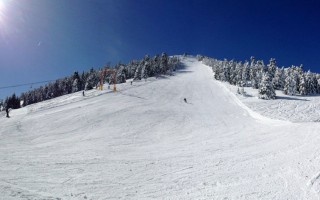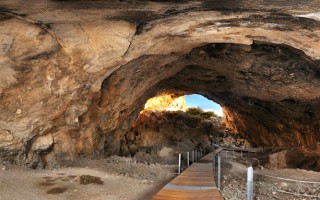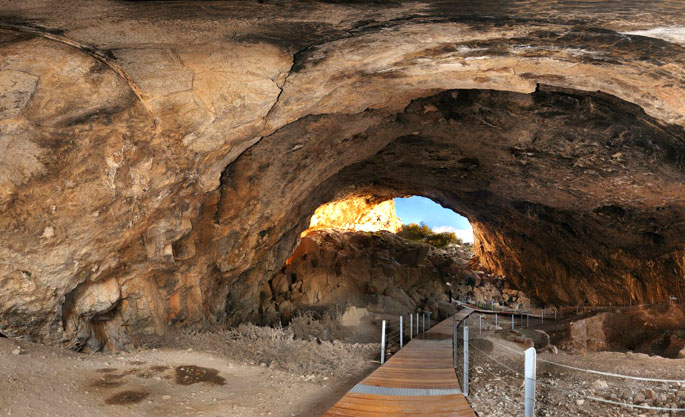Ten kilometres outside Tripoli, next to the village of Alea, in Mantineia, stands imposingly the ancient city of Tegea, fragments of which started emerging from the end of the previous century. Tegea was one of the most important cities of ancient Arcadia, with a remarkable course through the centuries, until 395 A.D., when it was completely destroyed by the Goths and subsequently abandoned.The excavations have thus far uncovered part of its ancient theatre, part of the ancient Agora, an altar for emperor worship, an early-Christian basilica and fragments of a Byzantine settlement. The area today can be visited and operates as an archaeological park. Nearby there is also the Archaeological Museum of Tegea, with findings mainly from the area around the sanctuary of Athena Alea, patron of Tegea. This sanctuary is no longer extant, it is said, however, that fragments from it were used to build the church of Panaghia, located near the archaeological site.
Tegea was one of the most significant cities of ancient Arcadia. It was founded by Tegeates, son of Lycaon and grandson of Pelasgus, and it was the last seat of the mythical kings of Arcadia. Tegea flourished during antiquity; it is said to have had several thousands of citizens, and it struck its own coins – an indication of its prosperity. The city was destroyed in 395 AD by the Goths, which led to its final decline.
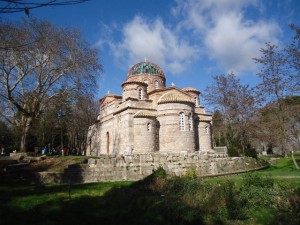 The temple of Alea Athena dominated the city, designed by the sculptor Skopas of Paros. Inside it stood an ivory statue of Athena, as well as statues of Asclepius and Hygeia, and the tusks of the Erymanthian Boar, which were taken to Rome when the city became part of the Roman Empire. According to mythology, the name “Alea” came from Aleus, the grandson of Arcas, who built the temple of the goddess Athena, protectress of Tegea. This temple no longer exists, but it is believed that parts were used to build the Christian church of Panagia, situated close to the archaeological site.
The temple of Alea Athena dominated the city, designed by the sculptor Skopas of Paros. Inside it stood an ivory statue of Athena, as well as statues of Asclepius and Hygeia, and the tusks of the Erymanthian Boar, which were taken to Rome when the city became part of the Roman Empire. According to mythology, the name “Alea” came from Aleus, the grandson of Arcas, who built the temple of the goddess Athena, protectress of Tegea. This temple no longer exists, but it is believed that parts were used to build the Christian church of Panagia, situated close to the archaeological site.
The excavations carried out at the site, initially by the French Archaeological School, and more recently by the Ephor of Antiquities, Theodoros Spyropoulos, brought to light temples of Athena Polias and Aphrodite, as well as a number of other buildings, such as the gymnasium, the agora, the stoa, the theatre, the stadium and the boule. Two paleo-Christian basilicas, an imperial cult altar and parts of a Byzantine village were also discovered in the area, from later periods. Only part of the one basilica is preserved, the so-called Thyrsos Basilica; the other is completely gone. The Norwegian Institute has been carrying out excavations since the 1990s, helping to identify buildings and roads in order to form a more complete picture of the area, while it also brought to light other findings, dating from the Byzantine periods and late antiquity.
The area today is an archaeological park of particular importance, with its own museum exhibiting the findings from the area.
Source: www.mythicalpeloponnese.gr
The Mansion of Herod Atticus is one of the most important and most impressive monuments in Arcadia. It is situated in Eva, in Doliana, an ancient town of Kynouria, which has been completely lost, but for a few samples of habitation. The mansion’s location was already known from the 19th century, however it was identified with certainty in 1906 by archaeologist Constantine Romeos.
 Herod Atticus, orator, philosopher and politician from a wealthy family, was also a fanatical collector of works of art. From his father he inherited a small mansion in Eva, which he decided to expand and to house his vast collection there, turning it into a sort of luxury museum. The mansion takes up approximately 20,000 m2 and includes a villa, a sanctuary, baths and a large atrium with galleries. The most impressive of all, however, are the mosaic floors; the total expanse of those discovered so far exceeds 1,300 m2. As the excavations and the research continue, it is very possible that others will come to light as well.
Herod Atticus, orator, philosopher and politician from a wealthy family, was also a fanatical collector of works of art. From his father he inherited a small mansion in Eva, which he decided to expand and to house his vast collection there, turning it into a sort of luxury museum. The mansion takes up approximately 20,000 m2 and includes a villa, a sanctuary, baths and a large atrium with galleries. The most impressive of all, however, are the mosaic floors; the total expanse of those discovered so far exceeds 1,300 m2. As the excavations and the research continue, it is very possible that others will come to light as well.
Unfortunately, before the regular excavations, a great part of the mansion’s treasures was destroyed due to ignorance, a fate which has befallen a great percentage of our cultural heritage.
Herodes Atticus (103-179 AD) was one of the most significant personalities of the Roman era in Greece. He was born into a rich family, which gave him the freedom to cultivate a multitude of interests and talents: he became an orator, philosopher and politician, while at the same time a prominent art collector, creating one of the most admirable collections of his time with rare and noteworthy works. From his father, Atticus, he inherited a small villa in Eva, Doliana, an ancient city of Kynouria situated close to the Loukous Monastery. Only few remnants of this city survive today. When Herodes completed his studies in Rome and Athens, he moved into this villa, impressed by the region’s rich history. It was the right place to house his rich collection, creating in this way a type of museum for ancient art, which was quite impressive in terms of its quality.
The location of the villa was known back in the 19th century, when English traveller William Martin Leake pointed it out. In the middle of the century, the area was visited by Ernst Gurtius, who noted that the ruins did not belong to some settlement, but to a villa. Archaeological findings were already bountiful in the area; according to the testimony of the monks of the adjacent Loukous Monastery, they would continually uncover antiquities while cultivating their land. The villa was identified in 1906 by Konstantinos Romaios, while systematic excavations started in 1979 by Theodoros Spyropoulos and continue to this day. The findings that have come to light are kept at the Archaeological Museums of Tripoli and Astros.
The Villa of Herodes Atticus covered a large area of 20,000 square metres, the largest villa in the Greek territory, following the Roman architecture style. It included a mansion, an atrium with galleries, a bath complex and a sanctuary. The archaeological findings that have come to light in fact verify the stories that this villa was a true museum. A number of sculptures, inscriptions and architectural parts have been revealed, most impressive of all, however, being the mosaic floors in various areas of the villa, with decoration, scenes and colours of high art. Currently, a large part of these mosaics has been uncovered, and future excavations are anticipated to reveal much more.
The villa unfortunately sustained repeated damage over the centuries, either owing to natural factors, or to raids and barbaric attacks, or even worse, to human indifference. The period of systematic excavations thankfully put an end to the lawless activities taking place in the region. Now it only remains for the villa to reveal its untold treasures lying hidden deep inside the earth.
Source: www.mythicalpeloponnese.gr
Ancient Gortys is among the most important Arcadian cities of the ancient world. The exact dates of its founding, prime and decline are not known, since the archaeological evidence that has come to light is not enough to make an estimation. It is generally accepted, however, that the city was in its prime already in the 4th century B.C., and it was probably destroyed sometime around the 12th century.
 The archaeological site is located outside the village of Atsilochos, in Mountainous Arcadia. Remnants that have come to light include fragments of the old fortification, ruins of houses and public buildings, a sanctuary of Asclepius and baths that were probably connected to this deity, with a curative purpose. The baths are among the most important ones to be discovered from the ancient world. They included a special heating system, which was considered by the researchers to be an Arcadian innovation.
The archaeological site is located outside the village of Atsilochos, in Mountainous Arcadia. Remnants that have come to light include fragments of the old fortification, ruins of houses and public buildings, a sanctuary of Asclepius and baths that were probably connected to this deity, with a curative purpose. The baths are among the most important ones to be discovered from the ancient world. They included a special heating system, which was considered by the researchers to be an Arcadian innovation.
The city also seems to be connected with the ancient city of the same name located in the valley of Mesara, near Heraklion, Crete. It is very possible that the Cretan Gortys was created by inhabitants of the Arcadian one.
According to myth, Ancient Gortys was founded by Gortys, the brother of Agamedes, son of Stymphalus and great grandson of King Arcas of the Lycaonides people. He gave his name to the city and also to River Lousios, which is called Gortynios at the stretch from Gortynia up to its confluence with river Alfeios. In antiquity, it was one of the most important cities of Arcadia and, according to what little is known, one of the oldest.
The city is situated next to River Lousios, at an altitude of 350 metres, a short distance outside the village of Atsilochos, in mountainous Arcadia. It was one of the stops on the route followed by Spartan athletes when travelling to compete in the Olympic Games, as the ancient road of Olympia – Megalopolis – Mycenae – Isthmus – Athens passed through here.
The city was guarded by two acropolises with strong fortifications, built close to one another, at an altitude of approximately 480 metres. It also had several temples and public buildings, burial grounds, a sanctuary of Asclepius, as well as two large baths, which formed an integral part of the worship of this deity. The baths operated from the 2nd century BC and had a special heating system, which archaeologists believe was an Arcadian invention. There was also a temple dedicated to Asclepius containing the god’s cult statue made by the famous sculptor Skopas of Paros. So renowned was this temple, according to Pausanias, that even Alexander the Great visited it in 335 BC, offered a sacrifice to the god and dedicated his spear and chest armour.
The exact date of the foundation of ancient Gortys is not known, owing principally to the lack of relevant written evidence and findings. There are, however, findings dating to the Late Helladic (1600-1100 BC) and up to the Geometric Period (11th – 8th century BC), thus verifying its age. The city’s most important period is placed during the Classical and Hellenistic Periods, with its peak specifically around the 4th century BC. Its decline, on the other hand, appears to have come after the foundation of Megali Polis, in 368 BC, when Gortys, together with neighbouring cities, was forced to unite with it, thus losing its autonomy. As a result, a large part of its population relocated to the new city. The city appears to have been finally destroyed around the 12th century AD, during the Byzantine Period, by the Goths.
During its peak years however, Gortys was a lively city, participating in the events of the wider region throughout its history.
Source: www.mythicalpeloponnese.gr
 The Nautical Club of New Epidaurus and the Nautical Sports Club of Peace and Friendship organize every June a sailing race in the deep blue sea of New Epidaurus and the Argosaronic Gulf. The Open Sea Sailing Race “Epidaurus” is so vivid, passionate and intense that it will definitely move you. Come to the beautiful port of New Epidaurus and give a very warm applaud to the contestants in a great evening accompanied by folk dances. It’s really worth the trip.
The Nautical Club of New Epidaurus and the Nautical Sports Club of Peace and Friendship organize every June a sailing race in the deep blue sea of New Epidaurus and the Argosaronic Gulf. The Open Sea Sailing Race “Epidaurus” is so vivid, passionate and intense that it will definitely move you. Come to the beautiful port of New Epidaurus and give a very warm applaud to the contestants in a great evening accompanied by folk dances. It’s really worth the trip.
Source: www.mythicalpeloponnese.gr
Frachthi cave is a world famous monument situated at the wild rocky mountain opposite the village Koilada. Excavations brought to light numerous findings among which the oldest human skeleton attesting its continuous occupation for more than 20.000 years. Walk through the beach Lampagianna, climb to the cave and enjoy the view.
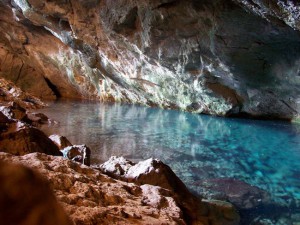 The world famous Frachthi cave is located next to the sea, opposite Koilada village, on a rocky hill covered by shrubs. Visitors can wander in the two chambers of the cave and admire the reflecting sun rays on the small lake situated in the center of the cave. It is west oriented, at an elevation of 12.5m over sea level and in a distance of 50m from the shore. Its total depth reaches 150m. In the past, during the Stone Age the distance to the sea was larger.The cave was first inhabited by the Homo Neanderdhal during the Paleolithic age (40.000 B.C.) and it was re-occupied by homo sapiens (wise human) after 30.000B.C. There are elements illustrating its continuous occupation from 25.000 B.C. to 30.000 B.C. when it was destroyed by a big earthquake.
The world famous Frachthi cave is located next to the sea, opposite Koilada village, on a rocky hill covered by shrubs. Visitors can wander in the two chambers of the cave and admire the reflecting sun rays on the small lake situated in the center of the cave. It is west oriented, at an elevation of 12.5m over sea level and in a distance of 50m from the shore. Its total depth reaches 150m. In the past, during the Stone Age the distance to the sea was larger.The cave was first inhabited by the Homo Neanderdhal during the Paleolithic age (40.000 B.C.) and it was re-occupied by homo sapiens (wise human) after 30.000B.C. There are elements illustrating its continuous occupation from 25.000 B.C. to 30.000 B.C. when it was destroyed by a big earthquake.
Originally it was occupied by some hunters that had found refuge in it. During the Middle and Later Neolithic Age more people begun to gather. Sediments that date from the Upper Paleolithical to the Neolithical age have been found in the cave. The excavations conducted in 1967-1976 and 1980-1982 by professors of the Universities of Indiana, brought to light numerous findings that illustrate the continuous inhabitance of the cave during the Stone Age.
 The findings included stone and bone tools, statuettes, ceramic vessels, jewels, shells, and other objects. A rare series of fish bones, mainly of tuna fish was also brought to light. The most significant find, though, is the most ancient human skeleton of a 25years old man, found in a fetal position under a pile of rocks. It is believed that he lived in the cave 10.000-8.000 years ago. More human skeletons were found in the cave providing the average height of humans. Remains of obsidian items found in the cave have been traced to the island of Melos indicating that humans of that period could realize long sea distance travels.
The findings included stone and bone tools, statuettes, ceramic vessels, jewels, shells, and other objects. A rare series of fish bones, mainly of tuna fish was also brought to light. The most significant find, though, is the most ancient human skeleton of a 25years old man, found in a fetal position under a pile of rocks. It is believed that he lived in the cave 10.000-8.000 years ago. More human skeletons were found in the cave providing the average height of humans. Remains of obsidian items found in the cave have been traced to the island of Melos indicating that humans of that period could realize long sea distance travels.
The excavations have been carried out only in the front part of the cave, extending to a surface of 700m. The rest of the cave remains intact keeping its secrets unrevealed. The finds are exhibited in the Archaeological Museum of Nafplio.
The Paleolithical house is a worth visiting and can be accessed by land and by sea. You can also practice climbing on the rocks of the cave, trekking on the Lampagiannas beach and swimming in the crystal blue water.
Source: www.mythicalpeloponnese.gr
 You can dock your boat at the beautiful and windless port of Porto Heli and enjoy your stay in this cosmopolitan location. The bay is full of yachts and cabin cruisers savoring the warmth of this charming bay.
You can dock your boat at the beautiful and windless port of Porto Heli and enjoy your stay in this cosmopolitan location. The bay is full of yachts and cabin cruisers savoring the warmth of this charming bay.
 The cosmopolitan town of Porto Heli is one of the most famous summer tourist destinations in Argolida. Its port is located in a closed and protected gulf that protects the boats from wind. Thanks to its optimum infrastructure and its large capacity, it hosts numerous yachts, inflatable crafts and all kinds of vessels that dock here every summer to enjoy its luxurious restaurants, taverns, cafeterias and bars. Maritime transportation connects the port to the islands of the Argosaronic gulf and Piraeus. Cruises to nearby coast side destinations are organized on a daily base.
The cosmopolitan town of Porto Heli is one of the most famous summer tourist destinations in Argolida. Its port is located in a closed and protected gulf that protects the boats from wind. Thanks to its optimum infrastructure and its large capacity, it hosts numerous yachts, inflatable crafts and all kinds of vessels that dock here every summer to enjoy its luxurious restaurants, taverns, cafeterias and bars. Maritime transportation connects the port to the islands of the Argosaronic gulf and Piraeus. Cruises to nearby coast side destinations are organized on a daily base.
Source: www.mythicalpeloponnese.gr
Thermisia lagoon is an important habitat of rare migratory birds. It is a serene and unique lagoon surrounded by a breathtaking landscape.
 Located in the picturesque village of Thermisia, to the east of Ermioni, the lagoon took its name from some hot springs that existed in the area. The Greek traveler Pausanias mentions a temple dedicated to Demeter Thermasia. This magnificent lagoon was used as a salt lake during the Venetian occupation and in modern times it hosted fish hatcheries. Today, it is of one of the most significant habitats in the region and it has been integrated in national and international protection networks; namely the European network CORINE BIOTOPS. The rare species that seek refuge in the site are protected under the European directive 79/409 and the Bern Convention.
Located in the picturesque village of Thermisia, to the east of Ermioni, the lagoon took its name from some hot springs that existed in the area. The Greek traveler Pausanias mentions a temple dedicated to Demeter Thermasia. This magnificent lagoon was used as a salt lake during the Venetian occupation and in modern times it hosted fish hatcheries. Today, it is of one of the most significant habitats in the region and it has been integrated in national and international protection networks; namely the European network CORINE BIOTOPS. The rare species that seek refuge in the site are protected under the European directive 79/409 and the Bern Convention.
Thousands of rare migratory birds visit the lagoon every year; herons, Gull-billed Terns (Gelochelidon nilotica), starlings (Sturnus vulgaris), glossy ibis (Plegadis falcinellus), the great egret (Egretta alba) and numerous other species.
Source: www.mythicalpeloponnese.gr
Every year since 1995, the “Epidaurus Festival” is organized, offering the visitor the opportunity to watch various performances at the imposing ancient theater of Epidaurus. So if you love ancient drama, you must visit this picturesque theater especially on a cool Friday or Saturday night under the moonlight. While it gets dark, you will be able to enjoy the amazing lyrics of the ancient dramatists played by the best and most talented actors.
Source: www.mythicalpeloponnese.gr
During the beautiful, magical nights in end June every little romantic corner of Nafplion is filled with beautiful sounds and melodies coming from the “Naflpion Festival”. Come and join us in this unforgettable musical journey.
Source: www.mythicalpeloponnese.gr
Unknown but yet beautiful, the Katafyki gorge invites you to a relaxing but charming walk. Wild birds, lush vegetation, gurgling waters and spectacular caves compose a unique painting
Katafyki gorge is a beautiful natural landscape, located between the villages of Fournoi and Ermioni. It consists of a protected area of outstanding beauty and a wild life refuge that attracts the most demanding visitors. Hikers can leave their car in Ermioni and take the path that passes through the dense vegetation of pines, laurels, myrtles, shrubs and other endemic plants. The sound of the running water and the presence of rare animals and wild birds give the impression of an earthly paradise. The imposing rough rocks host mysterious caves, one of which is said to consist of the entrance to the underworld, the point from where Hercules found Cerberus. The locals narrate stories of various offenders that used the caves as refuge.
At the exit of the gorge, near Ermioni, lies the byzantine church of Saint Nikolaos that, since 1740 according to local tradition, protects its visitors from the bad spirits.
The gorge is the ideal spot for hiking and climbing even for the inexperienced climbers. You can start from the gorge and, through the old bridge, reach the picturesque village Fournoi.
Source: www.mythicalpeloponnese.gr






